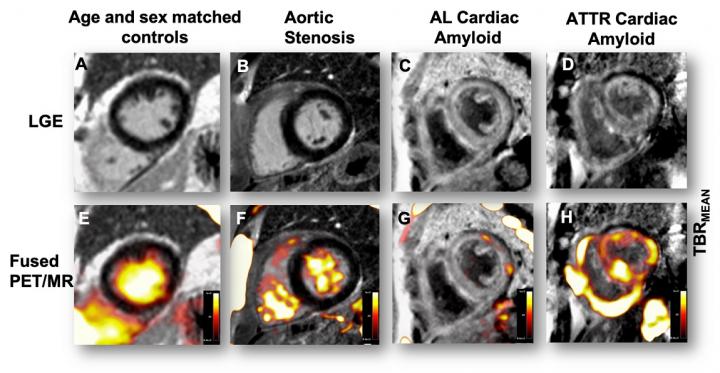18 Nov 20. SINAPSE Image of the Month
Edinburgh Imaging is proud to see that Dr Jack Andrews & Prof Marc Dweck's image of 18F-fluoride PET-MR imaging of the heart differentiates between cardiac amyloid subtypes, healthy volunteers & phenotypically similar patients with aortic stenosis featured as the SINAPSE image-of-the-month in November 2020.

Courtesy of Dr Jack Andrews & Prof Marc Dweck, this image shows late gadolinium-enhanced (LGE) cardiac MR images [top row] & corresponding fused 18F-fluoride cardiac MR-PET images [bottom row] comparing radiotracer uptake patterns across four cohorts of study participants in columns from left to right: Age & sex matched controls, patients with aortic stenosis, & patients with cardiac amyloid of two subtypes: amyloid light chain (AL) & amyloidosis transthyretin (ATTR).
Gadolinium-enhanced MR is widely used to diagnose cardiac amyloid, but cannot differentiate AL & ATTR subtypes which are associated with different prognoses & different treatment strategies.
A single MR-PET scan enables the accurate diagnosis of cardiac amyloid from MR with clear discrimination of AL & TTR amyloid from 18F-fluoride PET in co-registered images.
The mean target to background ratio (TBR) values in the image above demonstrate uptake greater in the blood pool than myocardium for a control subject (E) & a patient with aortic stenosis (F), contrasted with an AL amyloid patient displaying a characteristic distribution of myocardial LGE (C) & patchy myocardial uptake greater than the blood pool (G) whereas a TTR amyloid patient displaying similar LGE findings (D) is distinguished by extensive biventricular uptake (H).
These findings show promise for 18F-fluoride cardiac MR-PET imaging in the diagnosis & monitoring of patients with TTR amyloid.
The image is taken from a recently published multicentre study that conducted hybrid 18F-fluoride imaging with participants recruited in Edinburgh & New York, notably one of the first publications of data from the first MR PET system in Scotland (opened in 2017 at Edinburgh Imaging Facility QMRI):
Social media tags & titles
Edinburgh Imaging is proud to see that Dr Jack Andrews & Prof Marc Dweck's image of 18F-fluoride PET-MR imaging of the heart differentiates between cardiac amyloid subtypes, healthy volunteers & phenotypically similar patients with aortic stenosis featured as the SINAPSE image-of-the-month in November 2020. @Jackandrews86 @MarcDweck @SINAPSECENTRE @EdinUniCVS

